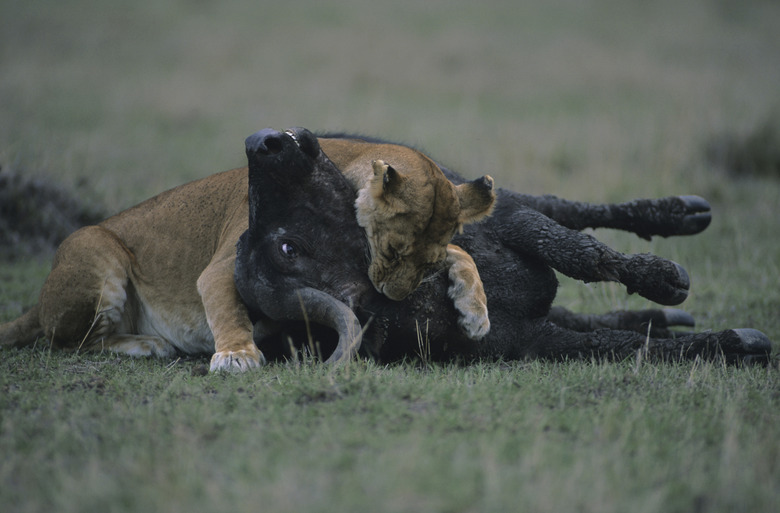Define Food Chains In Biology
Food chains are feeding relationships between categories of organisms. They are fundamental concepts within the study of ecology.
Knowing how to understand and define food chain connections helps you understand how energy flows in an ecosystem and how pollutants accumulate.
At the bottom of the food chain are producers, which are plants and algae that capture sunlight and carbon dioxide gas to make sugar via photosynthesis. Next are plant-eaters, such as cows. Then meat-eaters, such as humans and bears, eat the plant-eaters. Lastly, decomposers, some of which are microscopic, break down all dead organisms into molecules.
Producers
Producers
At the beginning of the food chain are producers, or organisms that are photosynthetic. Photosynthesis is the conversion of light energy from the sun in order to fix atmospheric carbon dioxide gas into glucose, a sugar. On land, producers are plants.
In the ocean, producers are microscopic algae. Life as we know it on Earth would not exist without producers, because animals in the higher food-chain categories must eat producers in order to get their source of organic carbon, or carbon that is digestible.
Primary Consumers
Primary Consumers
Primary consumers are herbivores, or organisms that eat plants, algae or fungi. Primary consumers are usually small rodents or insects that feed on plants. However, they can also be large animals such as baleen whales that filter out and feed on algae in the ocean.
Humans can also be primary consumers, since we are omnivores, meaning we eat both plants and animals. Additional examples of primary consumers are caterpillars, rabbits, hummingbirds and cows.
Secondary & Tertiary Consumers
Secondary & Tertiary Consumers
Secondary consumers are usually carnivores, meaning they get energy by eating only herbivore animals. Some secondary consumers are frogs that eat insects, snakes that eat frogs and foxes that eat rabbits.
Tertiary consumers are carnivores that eat secondary consumers. Tertiary consumers are usually larger than their prey. Some examples of tertiary consumers are eagles that eat snakes, humans who eat alligators and killer whales that eat seals.
Decomposers
Decomposers
Decomposers can range from microscopic organisms to large mushrooms. They feed on dead plants and animals. In this way, they consume all other organisms in the food chain. Decomposers include bacteria and fungi.
One class of decomposers are called saprobes, which grow in decaying organic matter. An example of a saprobe is a mushroom that grows on a fallen tree. Decomposers serve a critical role in the ecosystem by breaking down organic matter into ammonia and phosphates, helping to recycle nitrogen and phosphorous into the nitrogen and phosphorous geochemical cycles, respectively.
Bioaccumulation
Bioaccumulation
Just like nutrients and energy, pollutants also get transferred in an ecosystem via food chains. The accumulation of chemical pollutants, also known as bioaccumulation, has been documented to severely endanger consumers.
Heavy metal pollutants, such as lead and mercury, have become a widespread problem for marine ecosystems. In marine habitat that is severely polluted with mercury, all marine organisms of the habitat will absorb some amount of mercury during respiration or feeding. Since mercury cannot be easily eliminated from the body, a small amounts of mercury builds up in each organism. This buildup of toxins is called bioaccumulation.
As the marine food chain progresses and one organism feeds on another, the accumulated mercury gets transferred along with nutrients and energy at each level. Thus, small amounts of mercury from each level of the food chain gets consumed by the top-level consumer, leading to a large amount of mercury buildup. This process of increased buildup of toxins is called biomagnification.
While bioaccumulation affects all organisms in a polluted habitat, biomagnification mainly affects tertiary consumers, who are at the apex of a food chain. Biomagnification of toxins has endangered many species of tertiary consumers such as eagles and sharks.
Cite This Article
MLA
Ph.D., David H. Nguyen,. "Define Food Chains In Biology" sciencing.com, https://www.sciencing.com/define-food-chains-biology-9797/. 18 June 2019.
APA
Ph.D., David H. Nguyen,. (2019, June 18). Define Food Chains In Biology. sciencing.com. Retrieved from https://www.sciencing.com/define-food-chains-biology-9797/
Chicago
Ph.D., David H. Nguyen,. Define Food Chains In Biology last modified August 30, 2022. https://www.sciencing.com/define-food-chains-biology-9797/
